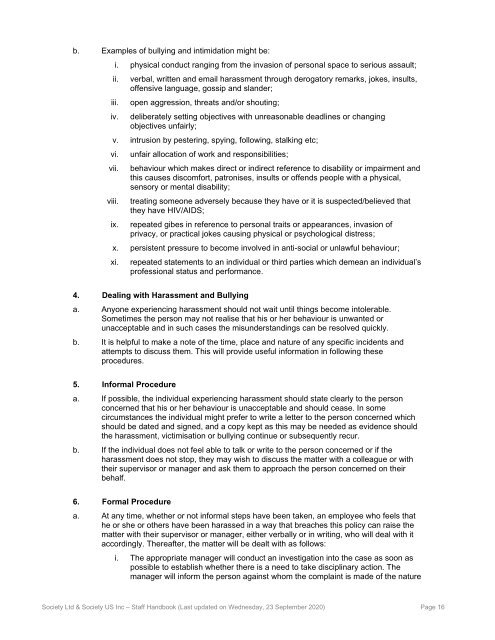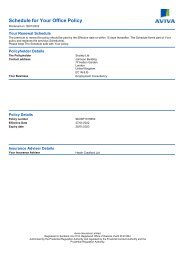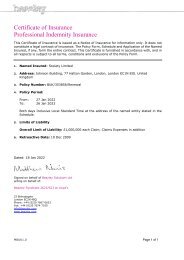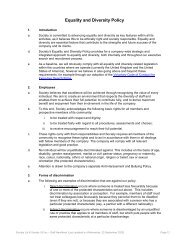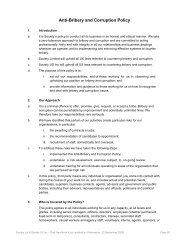Anti-Harassment and Bullying Policy
Create successful ePaper yourself
Turn your PDF publications into a flip-book with our unique Google optimized e-Paper software.
. Examples of bullying <strong>and</strong> intimidation might be:<br />
i. physical conduct ranging from the invasion of personal space to serious assault;<br />
ii.<br />
iii.<br />
iv.<br />
verbal, written <strong>and</strong> email harassment through derogatory remarks, jokes, insults,<br />
offensive language, gossip <strong>and</strong> sl<strong>and</strong>er;<br />
open aggression, threats <strong>and</strong>/or shouting;<br />
deliberately setting objectives with unreasonable deadlines or changing<br />
objectives unfairly;<br />
v. intrusion by pestering, spying, following, stalking etc;<br />
vi.<br />
vii.<br />
viii.<br />
ix.<br />
unfair allocation of work <strong>and</strong> responsibilities;<br />
behaviour which makes direct or indirect reference to disability or impairment <strong>and</strong><br />
this causes discomfort, patronises, insults or offends people with a physical,<br />
sensory or mental disability;<br />
treating someone adversely because they have or it is suspected/believed that<br />
they have HIV/AIDS;<br />
repeated gibes in reference to personal traits or appearances, invasion of<br />
privacy, or practical jokes causing physical or psychological distress;<br />
x. persistent pressure to become involved in anti-social or unlawful behaviour;<br />
xi.<br />
repeated statements to an individual or third parties which demean an individual’s<br />
professional status <strong>and</strong> performance.<br />
4. Dealing with <strong>Harassment</strong> <strong>and</strong> <strong>Bullying</strong><br />
a. Anyone experiencing harassment should not wait until things become intolerable.<br />
Sometimes the person may not realise that his or her behaviour is unwanted or<br />
unacceptable <strong>and</strong> in such cases the misunderst<strong>and</strong>ings can be resolved quickly.<br />
b. It is helpful to make a note of the time, place <strong>and</strong> nature of any specific incidents <strong>and</strong><br />
attempts to discuss them. This will provide useful information in following these<br />
procedures.<br />
5. Informal Procedure<br />
a. If possible, the individual experiencing harassment should state clearly to the person<br />
concerned that his or her behaviour is unacceptable <strong>and</strong> should cease. In some<br />
circumstances the individual might prefer to write a letter to the person concerned which<br />
should be dated <strong>and</strong> signed, <strong>and</strong> a copy kept as this may be needed as evidence should<br />
the harassment, victimisation or bullying continue or subsequently recur.<br />
b. If the individual does not feel able to talk or write to the person concerned or if the<br />
harassment does not stop, they may wish to discuss the matter with a colleague or with<br />
their supervisor or manager <strong>and</strong> ask them to approach the person concerned on their<br />
behalf.<br />
6. Formal Procedure<br />
a. At any time, whether or not informal steps have been taken, an employee who feels that<br />
he or she or others have been harassed in a way that breaches this policy can raise the<br />
matter with their supervisor or manager, either verbally or in writing, who will deal with it<br />
accordingly. Thereafter, the matter will be dealt with as follows:<br />
i. The appropriate manager will conduct an investigation into the case as soon as<br />
possible to establish whether there is a need to take disciplinary action. The<br />
manager will inform the person against whom the complaint is made of the nature<br />
Society Ltd & Society US Inc – Staff H<strong>and</strong>book (Last updated on Wednesday, 23 September 2020) Page 16


